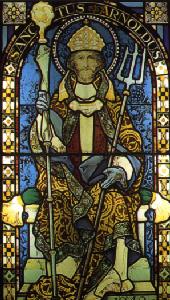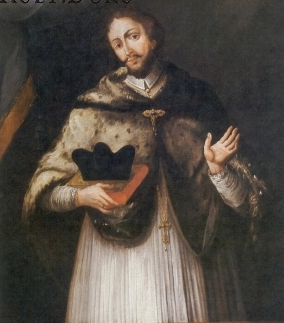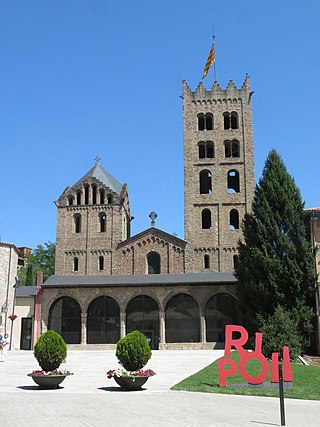Related Research Articles

Oudenburg is a city and municipality located in the Belgian province of West Flanders. The municipality comprises the city of Oudenburg itself and the towns of Ettelgem, Roksem and Westkerke. On January 1, 2006 Oudenburg had a total population of 8,929. The total area is 35.38 km2 which gives a population density of 252 inhabitants per km2.
Eudoxius was the eighth bishop of Constantinople from January 27, 360 to 370, previously bishop of Germanicia and of Antioch. Eudoxius was one of the most influential Arians.
Evagrius Scholasticus was a Syrian scholar and intellectual living in the 6th century AD, and an aide to the patriarch Gregory of Antioch. His surviving work, Ecclesiastical History, comprises a six-volume collection concerning the Church's history from the First Council of Ephesus (431) to the emperor Maurice’s reign until Scholasticus' death.
Theophilus was the 23rd Pope of Alexandria and Patriarch of the Seat of Saint Mark. He became pope at a time of conflict between the newly dominant Christians and the pagan establishment in Alexandria, each of which was supported by a segment of the Alexandrian populace.

Arnold (Arnoul) of Soissons or Arnold or Arnulf of Oudenburg is a saint of the Catholic Church, the patron saint of hop-pickers, Belgian brewers.

Hucbald was a Benedictine monk active as a music theorist, poet, composer, teacher, and hagiographer. He was long associated with Saint-Amand Abbey, so is often known as Hucbald of St Amand. Deeply influenced by Boethius' De Institutione Musica, Hucbald's (De) Musica, formerly known as De harmonica institutione, aims to reconcile ancient Greek music theory and the contemporary practice of Gregorian chant with the use of many notated examples. Among the leading music theorists of the Carolingian era, he was likely a near contemporary of Aurelian of Réôme, the unknown author of the Musica enchiriadis, and the anonymous authors of other music theory texts Commemoratio brevis, Alia musica, and De modis.

The Tironensian Order or the Order of Tiron was a medieval monastic order named after the location of the mother abbey in the woods of Thiron-Gardais in Perche, some 35 miles west of Chartres in France). They were popularly called "Grey Monks" because of their grey robes, which their spiritual cousins, the monks of Savigny, also wore.

The County of Loon was a county in the Holy Roman Empire, which corresponded approximately with the modern Belgian province of Limburg. It was named after the original seat of its count, Loon, which is today called Borgloon. During the middle ages the counts moved their court to a more central position in Kuringen, which today forms part of Hasselt, capital of the province.

Subiaco is a comune (municipality) in the Metropolitan City of Rome Capital, in the Italian region of Latium, 40 kilometres (25 mi) from Tivoli alongside the River Aniene. It is a tourist and religious resort because of its sacred grotto, in the medieval St. Benedict's Abbey, and its Abbey of Santa Scolastica. It is one of I Borghi più belli d'Italia. The first books to be printed in Italy were produced here in the late 15th century.

Averbode Abbey is a Premonstratensian abbey situated in Averbode, in the municipality Scherpenheuvel-Zichem, in the Archdiocese of Mechelen-Brussels in Belgium. It was founded about 1134, suppressed in 1797, and reestablished in 1834. Throughout the 20th century the abbey press was a leading children's publisher in Belgium. The church's building is a peculiar synthesis of Baroque and Gothic, with Renaissance ornament details, dominating the monastery complex. The whole structure was built of iron sandstone from Langdorp and white sandstone from Gobertange between 1664 and 1672, after a design by the Antwerp architect Jan Van den Eynde II.
Herigerus was a Benedictine monk, often known as Heriger of Lobbes for serving as abbot of the abbey of Lobbes between 990 and 1007. Remembered for his writings as theologian and historian, Herigerus was a teacher to numerous scholars. His biography describes him as "skilled in the art of music", though no music theory treatise survives and neither do the two antiphons and one hymn attributed to him.

Gembloux Abbey was a Benedictine abbey near Gembloux in the province of Namur, Wallonia, Belgium. Since 1860, its buildings host the University of Liège's Gembloux Agro-Bio Tech faculty and campus.

Gerhoh of Reichersberg was one of the most distinguished theologians of Germany in the twelfth century. He was provost of Reichersberg Abbey and a Canon Regular.

The Monastery of Santa Maria de Ripoll is a Benedictine monastery, built in the Romanesque style, located in the town of Ripoll in Catalonia, Spain. Although much of the present church is 19th century rebuilding, the sculptured portico is a renowned work of Romanesque art.
Praepositinus was an Italian scholastic philosopher and theologian. He was a liturgical commentator, and supported a res-theory of belief. He discussed intentional contexts.

The Ecclesiastical History, also known as The History of the Church and Church History, is a 4th-century chronological account of the development of Early Christianity from the 1st century to the 4th century, composed by Eusebius, the bishop of Caesarea. It was written in Koine Greek and survives also in Latin, Syriac, and Armenian manuscripts.

John Stanley Kenneth Arnold is the eleventh Roman Catholic Bishop of Salford. He was formerly an auxiliary bishop of the Roman Catholic Archdiocese of Westminster and held the titular see of Lindisfarne.
Flavius Longinus was a politician of the Eastern Roman Empire, brother of Emperor Zeno and twice consul.
Heraclius was an influential eunuch of the Western Roman Emperor Valentinian III.
William Reading (1674–1744) was an English clergyman and librarian of Sion College, known for his edition of early church historians.
References
- ↑ A. Lambert, "Arnold Scholasticus", Dictionnaire d'histoire et de géographie ecclésiastiques, vol. 4 (Paris, 1930), 572-573.